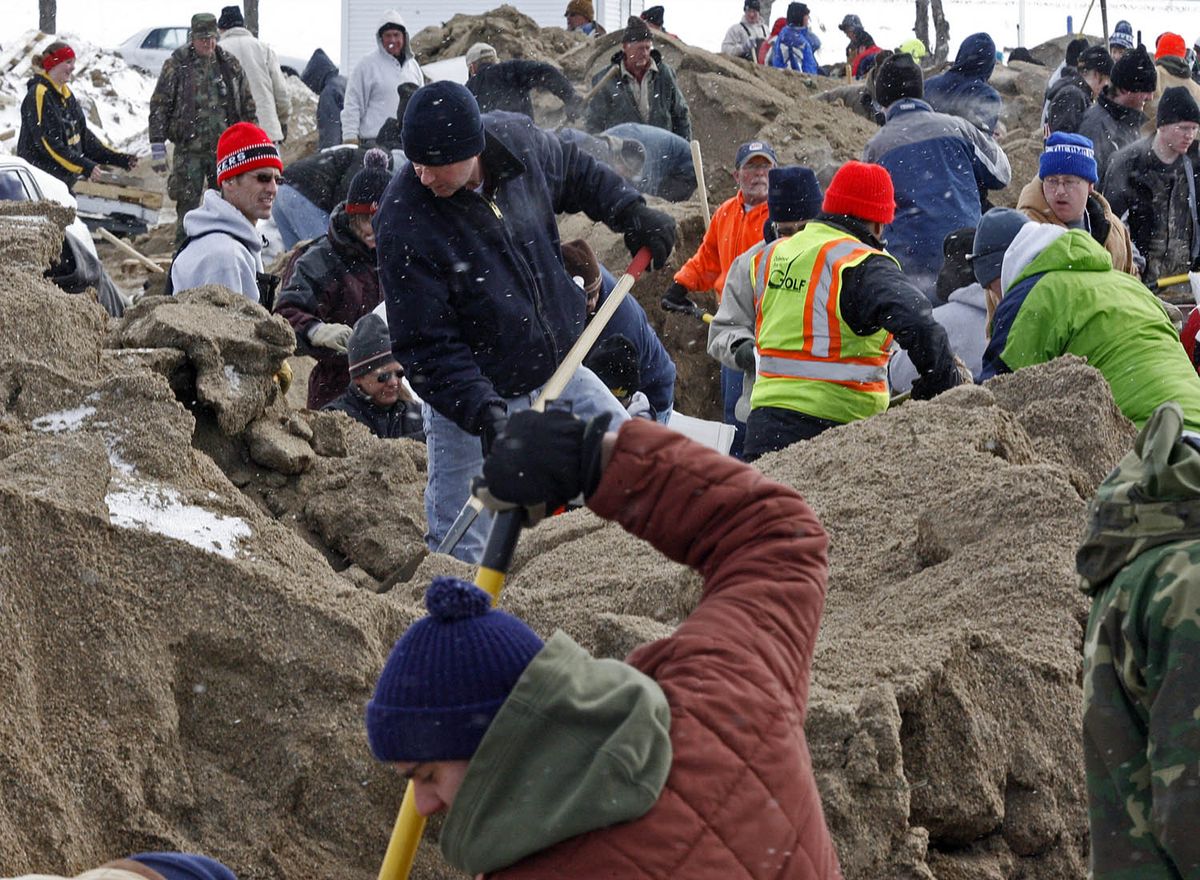Soggy, nervous wait begins
Days and nights of sandbagging fortify Red River dike at Fargo

FARGO, N.D. – For days, this city has hunkered down for battle with the swelling Red River. Volunteers shoveled sand into bags, heaved them onto forklifts and piled them high to shield waterfront churches and bungalow homes. It was a way to cope with potential catastrophe – unlike an earthquake, a flood can be anticipated and stopped.
But by late Friday, the 12-mile, man-made barrier was complete. Sand-bagging wound down. Some neighborhoods, both here and in neighboring Moorhead, Minn., were evacuated. Nursing homes were emptied. About 1,700 National Guard troops marched into town.
Fargo settled in to wait and worry.
The river is expected to crest Sunday, possibly as high as the city’s main 43-foot dike. Authorities said they had no plans – and no time – to make the barrier higher.
“Is that a gamble?” said Mayor Dennis Walaker. “We don’t think so.”
Subfreezing temperatures have kept runoff from inundating the waterway, said Patrick Slattery, a National Weather Service spokesman. But it’s expected to remain swollen for days, which could weaken the makeshift barriers.
Officials discouraged traveling for much of the day; thousands had already fled the city. Flurries dusted boutiques with darkened windows and empty downtown streets. Tractors and backhoes whirred.
“It’s terrifying thinking about what comes next,” said Steve Wennblom, 52, who was helping St. John Lutheran Church clear its basement of choir robes and hymnals.
In Fargo, a city of 90,000 with both a picturesque red-brick downtown and suburban chain stores, folks are by necessity conversant in water. The plains – so flat that some locals joke God sat here while creating the world – are often soaked this time of year, drenched by spring rains and melted snow.
Radio hosts flip like a toggle switch between farm market reports and flood threats. People recall a 1997 deluge with the same clarity as Sept. 11. Many folks have pinpointed how high the river can go before their basements become fetid pools. On Friday, everyone tracked the river’s height with a scientist’s precision.
5:15 a.m.: 40.32 feet.
8:30 a.m.: 40.52 feet.
12:45 p.m.: 40.67 feet, and slowly rising.
The river swelled Friday night to 40.8 feet – more than 22 feet above flood stage and beyond the previous high-water mark of 40.1 feet in 1897.
Joel Davy, a 62-year-old architect who lives just south of a neighborhood under voluntary evacuation, bagged sand this week until his eyes were bleary and his voice hoarse.
“You’re not sitting around terrified,” he explained. “You’re trying to beat it.”
His wife, Deborah, a 53-year-old English teacher, joined him after school Thursday. They had just learned the river might reach 43 feet – far higher than previous predictions, and the source of a new local saying: “One more day, one more foot.”
Mark Tokheim, 39, had been roused from bed about 11 p.m. Thursday. Authorities needed volunteers to fortify the earthen levee near his home in another riverfront neighborhood. Several hundred people showed up, and many worked until dawn stacking sandbags they compared to frozen turkeys.
“I saw the water within a foot of the earthen dike and that made it real,” he said. “That’s where I’m normally biking. I’d be underwater if I was on the bike path.”
About 2 a.m. Friday, the exhausted crew was again reminded of the stakes: A dike to the south had sprung a leak. Authorities knocked on doors and urged homeowners there to evacuate.